Abstract
This paper considers linear programming problems (LPPs) where the objective functions involve discrete fuzzy random variables (fuzzy set-valued discrete random variables). New decision making models, which are useful in fuzzy stochastic environments, are proposed based on both possibility theory and probability theory. In multi-objective cases, Pareto optimal solutions of the proposed models are newly defined. Computational algorithms for obtaining the Pareto optimal solutions of the proposed models are provided. It is shown that problems involving discrete fuzzy random variables can be transformed into deterministic nonlinear mathematical programming problems which can be solved through a conventional mathematical programming solver under practically reasonable assumptions. A numerical example of agriculture production problems is given to demonstrate the applicability of the proposed models to real-world problems in fuzzy stochastic environments.
1. Introduction
One of the traditional tools for taking into consideration uncertainty of parameters involved in mathematical programming problems is stochastic programming [1,2]. Stochastic programming approaches implicitly assume that uncertain parameters involved in problems can be expressed as random variables. For example, demanding amounts of products are often mathematically modeled as random variables. In this case, realized values of random parameters under event occurrence are assumed to be represented with deterministic values such as real values.
On the other hand, random variables are not always suitable to estimate parameters of problems, when human judgments and/or knowledge have to be mathematically handled. It is worth utilizing not only historical or past data but also experts’ knowledge or judgments involving ambiguity or vagueness which are often represented as fuzzy sets.
Simultaneous consideration of fuzziness and randomness is highly important in modeling decision making problems, because decision making by humans in stochastic environments is intrinsically based not only on randomness but also on fuzziness. In the last decade, mathematical models which take into consideration both fuzziness and randomness have considerably drawn attentions in the research field of decision making such as linear programming [3,4,5,6,7,8,9,10,11,12], integer programming [13], inventory [14,15], transportation [16], facility layout [17], flood management [18] and network optimization [19,20].
In this paper, we focus on mathematical optimization models in fuzzy stochastic decision making situations where possible realized values of random parameters in linear programming problems (LPPs) are ambiguously estimated by experts as fuzzy sets or fuzzy numbers. Such fuzzy set-valued random variables, namely, random parameters whose realized values are represented with fuzzy sets, can be expressed as fuzzy random variables [21,22,23,24,25,26].
Previous studies on fuzzy random LPPs have mainly focused on the case where the coefficients of the objective function and the constraints are expressed by continuous fuzzy random variables, which is an extended concept of continuous random variables. Fuzzy random optimization models were firstly developed by Luhandjula and his colleagues [27,28] as LPPs with fuzzy random variable coefficients, and further studied by Liu [29,30], Katagiri et al. [4,6] and Yano [11] and so on. A brief survey of major fuzzy stochastic programming models including mathematical programming models using fuzzy random variables was found in the paper by Luhandjula [8].
On the other hand, there are a few studies [13,31,32] on LPPs with discrete fuzzy random variables. As will be discussed later in more details, it is quite important to propose more general fuzzy random LPP models in order to widen the range of application of fuzzy stochastic programming, which motivates this article to provide new generalized mathematical programming models with discrete fuzzy random variables.
This paper is organized as follows: In Section 2, the definitions of fuzzy random variables are introduced. Some types of fuzzy random variables are newly defined. Section 3 focuses on discrete fuzzy random variables and defines some types of discrete fuzzy random variables. Section 4 formulates a single/multiple objective LPP where the coefficients of the objective function(s) are discrete fuzzy random variables. In Section 5, we construct new optimization criteria for optimization problems with discrete fuzzy random variables, which are based both on possibility theory and on probability theory. Section 6 proposes decision making models using optimization criteria introduced in Section 5, and defines (weak) Pareto optimal solutions of the proposed models in the multi-objective case. Section 7 discusses how the proposed model can be solved and construct an algorithm for obtaining a Pareto optimal solution of the proposed models. In Section 8, we execute a numerical experiment with an example of agriculture production problems in order to demonstrate the applicability of the proposed model to real-world decision making problems. It is shown that the R [33] language can be used to solve the problems with hundreds of decision variables in a practical computational time. Finally, Section 9 summarizes this paper and discusses future research works.
2. Preliminaries
In this section, we review some mathematical concepts related to discrete fuzzy random variables, such as convex fuzzy sets and fuzzy numbers. Definitions of fuzzy random variables are also provided.
2.1. Fuzzy Set and Fuzzy Number
As a preparation for the introduction of fuzzy random variables, we firstly introduce the definition of fuzzy sets.
Definition 1.
(Normal convex fuzzy set)
A normal convex fuzzy set is characterized by a membership function , that is, , for all , such that is a nonempty compact interval
where denotes the closure of set , and denotes a support of membership function .
An L-R fuzzy number was introduced by Dubois and Prade [34] and is defined based on a normal convex fuzzy set.
Definition 2.
(L-R fuzzy number)
A normal convex fuzzy set is said to be an L-R fuzzy number, denoted by , if its membership function is defined as follows:
where L and R are reference functions satisfying the following conditions:
- 1.
- and are nonincreasing for any .
- 2.
- .
- 3.
- and for any .
- 4.
- There exists a such that holds for any t larger than . Similarly, there exists a such that holds for any t larger than .
Fuzzy numbers are regarded as extended concepts of real numbers because is reduced to a real number d if in Definition 2. Fuzzy numbers are a useful tool for representing human knowledge and/or estimation. Figure 1 shows a typical membership function of an L-R fuzzy number.
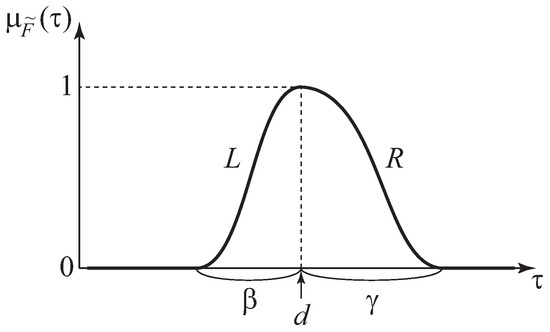
Figure 1.
L-R fuzzy number.
In Definition 2, if and , we call such an L-R fuzzy number an L fuzzy number. In other words, L fuzzy numbers are symmetric fuzzy numbers defined as follows:
Definition 3.
(L fuzzy number)
A normal convex fuzzy set is said to be an L fuzzy number if its membership function is defined as follows:
where L is a reference function satisfying the following conditions:
- 1.
- is nonincreasing for any .
- 2.
- .
- 3.
- for any .
- 4.
- There exists a such that holds for any t larger than .
Figure 2 shows a typical membership function of an L fuzzy number.
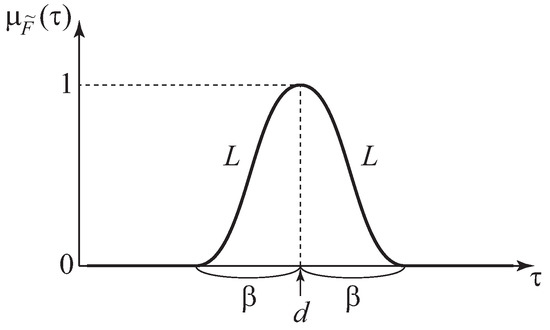
Figure 2.
L fuzzy number.
In Definition 2, if , we call such an L-R fuzzy number a triangular fuzzy number.
Definition 4.
(Triangular fuzzy number)
An L-R fuzzy number is said to be a triangular fuzzy number, denoted by , if the reference functions L and R of an L-R fuzzy number are given as . In other words, a triangular fuzzy number is characterized by the following piece-wise linear membership function:
Figure 3 shows a typical membership function of a triangular fuzzy number.
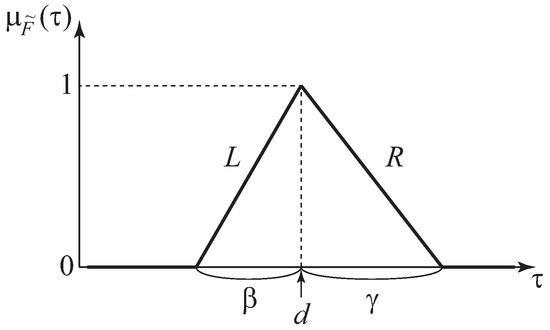
Figure 3.
Triangular fuzzy number.
2.2. Fuzzy Random Variable
In this section, we review and define some important concepts underlying fuzzy random programming problems. There are mainly two definitions of fuzzy random variables. A fuzzy random variable was firstly defined by Kwakernaak [24] as an extended concept of random variables in the sense that the realized values for given events or scenarios are not real but fuzzy numbers. Kruse and Meyer [35] provided some concepts similar to the model by Kwakernaak. Puri and Ralescu [25] defined fuzzy random variables as random fuzzy sets and developed a mathematical basis of fuzzy random variables with Klemment [23]. Overviews of fuzzy random variables have been provided by Gil et al. [22] and Shapiro [26].
We introduce a general definition of fuzzy random variables, which is based on the works of Kwakernaak [24], Kruse and Meyer [35] and Gil et al. [21]:
Definition 5.
(Fuzzy random variable)
Let be a probability space and denote the set of all fuzzy numbers in , where denotes a class of normal convex fuzzy subsets of having compact α level set for . A fuzzy random variable is a mapping such that for any and all , the real-valued mapping
and
are real-valued random variables, that is, Borel measurable real-valued functions. is a nonempty compact interval defined by
where is the membership function of a fuzzy set , denotes the closure of set , and denotes a support of function .
2.3. Special Types of Fuzzy Random Variables Used in Decision Making
For the purpose of applying fuzzy random variables to decision making problems, Katagiri et al. [4,6,20,36,37] introduced some special types of fuzzy random variables where the realized values of random variables for given events or scenarios are L-R fuzzy numbers or triangular fuzzy numbers. Since these fuzzy random variables are useful for modeling various decision making problems, we categorize these fuzzy random variables into several types such as L-R fuzzy random variable, L fuzzy random variable and triangular fuzzy random variable, together with their examples which were originally introduced in the previous papers.
First, we define L-R fuzzy random variable as follows:
Definition 6.
(L-R fuzzy random variable)
Let , and be random variables whose realization for a given event are , and , respectively, where Ω is a sample space, and and are positive constants for any . Then, a fuzzy random variable is said to be an L-R fuzzy random variable, denoted by , if its realized values for any event are L-R fuzzy numbers defined as
L-R fuzzy random variables were introduced to decision making problems such as a portfolio selection problem [38], an LPP [36] and a multi-objective programming problem [4]. In these studies, the coefficients of objective functions are represented as a special type of L-R fuzzy random variables in which the spread parameters and are constants, not random variables, as shown in the following example:
Example 1.
In Definition 6, let be a Gaussian (normal) random variable where m is the mean and σ is the standard deviation. Also, let and be positive constants, not random variables. Then, is a kind of L-R fuzzy random variables if the membership function of the realization of is defined as
where is a realized value of for a given event , and Ω is a sample space.
Another example of L-R fuzzy random variables is shown in the study on a multi-objective LPP [6] as follows:
Example 2.
Let , and be random variables expressed as
where is a random variable whose mean and variance are m and , respectively, and , , , , and are constant values. Then, is a kind of L-R fuzzy random variables if the membership function of the realization of is defined as
where is a realized value of for a given event , and Ω is a sample space.
When the reference functions of left-hand and right-hand sides are the same in Definition 6, namely, if it holds , we call such an L-R fuzzy random variable an L fuzzy random variable defined as follows:
Definition 7.
(L fuzzy random variable)
Let and be random variables whose realization for a given event are and , respectively, where Ω is a sample space, and is a positive constant for any . Then, a fuzzy random variable is said to be an L fuzzy random variable if its realized values for any event are L-R fuzzy numbers defined as
L fuzzy random variables were introduced in network optimization problems such as bottleneck minimum spanning tree problems [20,39]. In these studies, the cost for constructing each edge in an optimal network construction problem was expressed as an L fuzzy random variable shown in the following example:
Example 3.
In Definition 7, let be a Gaussian (normal) random variable where m is the mean and σ is the standard deviation. Also, let β be a positive constant, not a random variable. Then, is a kind of L fuzzy random variables if the membership function of the realization of is defined as
where is a realized value of for a given event , and Ω is a sample space.
The L fuzzy random variable shown in Example 3 can be interpreted as a “hybrid number.” The hybrid number, which was originally introduced by Kaufman and Gupta [40], is composed of a series of fuzzy numbers, and is obtained by shifting fuzzy numbers in a random way along the abscissa.
Especially if in Definition 6, we call such an L-R fuzzy random variable a triangular fuzzy random variable.
Definition 8.
(Triangular fuzzy random variable)
An L-R fuzzy random variable is said to be a triangular fuzzy random variable, denoted by , if the realization for each is represented by a triangular fuzzy number , where Ω is a sample space. In other words, a discrete triangular fuzzy random variable is a discrete fuzzy random variable whose realization for each event ω is a triangular fuzzy number characterized by the following membership function:
Triangular fuzzy random variables were introduced in the study on a multi-objective LPP [37]. In this study, spread parameters and are not random variables but constant values as shown in the following example:
Example 4.
In Definition 8, let and be positive constants, not random variables. Then, is a kind of triangular fuzzy random variables if the membership function of the realization of is defined as
where is a realized value of for a given event , and Ω is a sample space.
3. Discrete Fuzzy Random Variable
In this section, we discuss discrete fuzzy random variable as for a preparation for proposing a new framework of LPPs with discrete fuzzy random variables.
Firstly, we review the definition of discrete fuzzy random variable given by Kawakernaak [41]. Secondly, we provide the definition of discrete L-R fuzzy random variable and that of discrete triangular fuzzy random variable which was applied to a network optimization problem [31], an LPP [32] and a multi-objective 0-1 programming problem [13].
Definitions of Discrete Fuzzy Random Variables
In the 1970s, Kwakernaak [41] originally proposed a concept of discrete fuzzy random variable. In this paper, we provide the definition of discrete fuzzy random variable as follows:
Definition 9.
(Discrete fuzzy random variable)
Let Ω be a set of events such that the occurrence probability of each event is and that . Let be a fuzzy set characterized by a membership function , and let be a set of , , where K is an index set of k. Let be a mapping from Ω to such that . Then, a mapping is said to be a discrete fuzzy random variable.
Considering the applicability of the discrete fuzzy random variables in real-world decision making, we define discrete L-R fuzzy random variables as a special type of discrete fuzzy random variables.
Definition 10.
(Discrete L-R fuzzy random variable)
A discrete fuzzy random variable is said to be a discrete L-R fuzzy random variable, denoted by , if the realization of for any event is an L-R fuzzy number , where , and are the realized values of , , and for a given event , respectively, and Ω is a sample space. Then, is an L-R fuzzy random variable in which the membership function of the realization for each event is defined as
The following is an example of discrete L-R fuzzy random variables:
Example 5.
Consider and vary dependent on events or scenarios. Then, is a discrete L-R fuzzy random variable in which the membership functions of the realized fuzzy numbers of , are defined as follows:
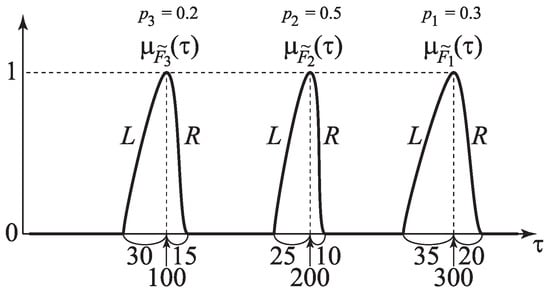
Figure 4.
Discrete L-R fuzzy random variable.
In particular, if in Definition 10, we call such a discrete L-R fuzzy random variable a discrete triangular fuzzy random variable.
Definition 11.
(Discrete triangular fuzzy random variable)
A discrete L-R fuzzy random variable is said to be a discrete triangular fuzzy random variable, denoted by , if the realization for each is represented by a triangular fuzzy number , where Ω is a sample space. In other words, a discrete triangular fuzzy random variable is a discrete fuzzy random variable whose realization for each event is a triangular fuzzy number characterized by the following membership function:
Example 6.
When it holds that in Example 5, is a discrete triangular fuzzy random variable whose realized values , are characterized by the following membership function:
Figure 5 shows a typical membership function of a discrete triangular fuzzy random variable.
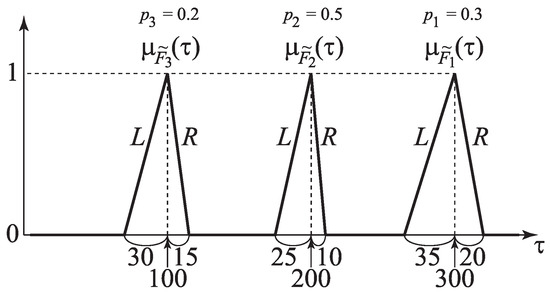
Figure 5.
Discrete triangular fuzzy random variable.
Discrete triangular fuzzy random variables were firstly introduced in some of previous studies on a network optimization problem [31], an LPP [32] and a multi-objective 0-1 programming problem [13].
In these studies, the spread parameters and do not vary with events but they are fixed as constants for any events. To the author’s best knowledge, there has been no study on linear programming model where the spread parameters and of discrete fuzzy random variables vary with different events .
In the next section we shall propose new linear programming models with discrete fuzzy random variables in which spread parameters vary with stochastic events.
4. Problem Formulation
Assuming that the coefficients of the objective functions are given as discrete fuzzy random variables, we consider the following fuzzy random programming problem:
where are n dimensional coefficient row vectors whose elements are discrete fuzzy random variables, x is an n dimensional decision variable column vector, A is an coefficient matrix, and b is an m dimensional column vector. When the number of objective functions is equal to 1 (), then problem (15) becomes a single-objective fuzzy random programming problem; otherwise, when , (15) is a multi-objective fuzzy random programming problem. In problem (15), all the objective functions are to be minimized. Without loss of generality, this paper considers minimization problems, because any maximization problems can be transformed into minimization problems by multiplying the original objective function in the maximization problem by .
4.1. Model Using Discrete L-R Fuzzy Random Variables
In problem (15), we firstly consider the case where each element of the coefficient vectors in (15) is a discrete L-R fuzzy random variable whose realization for a given event is an L-R fuzzy number , , , with the membership function defined as
where denotes a set of events related to the lth objective function. In (16), the values of , and are constant, and and are positive. The probability that each event occurs is given as , where , . Figure 6 shows that a typical membership function of an L-R fuzzy number defined by (16).
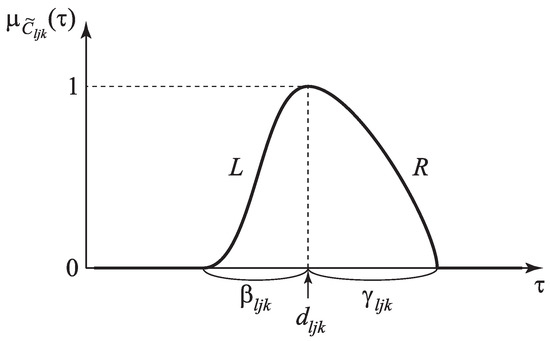
Figure 6.
Realized values for the kth event of a discrete L-R fuzzy random variable .
Through the extended sum of fuzzy numbers [42] based on the Zadeh’s extension principle [43], the objective function is represented by a single fuzzy random variable whose realized value for an event or scenario is an L-R fuzzy number characterized by the membership function
where , and are n dimensional column vectors whose values vary dependent on events . Figure 7 shows that the membership function of an L-R fuzzy number defined by (17).
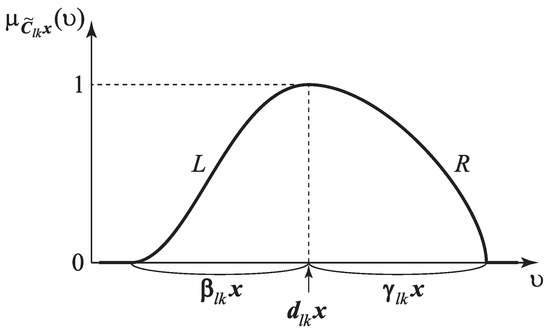
Figure 7.
Realized values for the kth event of a discrete L-R fuzzy random variable .
4.2. Model Using Discrete Triangular Fuzzy Random Variables
As a special type of discrete L-R fuzzy random variable defined in (17), we also consider the case where is a discrete triangular fuzzy random variable in which its realized values for events or scenarios are triangular fuzzy numbers for , , , with the following membership function:
Then, through the Zadeh’s extension principle, the realized value of each objective function for a given event is represented by a single triangular fuzzy number which is characterized by
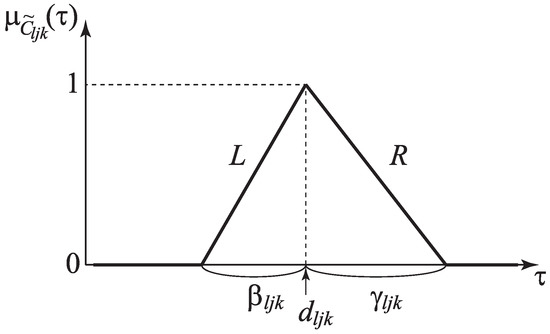
Figure 8.
Realized value for the kth event of a discrete triangular fuzzy random variable .
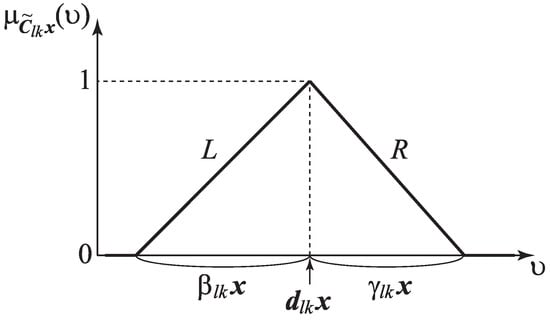
Figure 9.
Realized value for the kth event of a discrete triangular fuzzy random variable .
5. Possibility/Necessity-Based Probabilistic Expectation
This section is devoted to discussing optimization criteria to solve problem (15) with discrete fuzzy random variables whose realized values are given as L-R fuzzy numbers defined by (17) or triangular fuzzy numbers defined by (19).
It should be noted here that problem (15) is not a well-defined mathematical programming problem because, even when a decision vector x is determined, the objective function value is not determined as a constant due to both randomness and fuzziness of . In other words, a certain optimization criterion is needed to compare the value of fuzzy random objective function.
In this section, we propose some useful optimization criteria based on both possibility and probability measures, called a possibility/necessity-based probabilistic expectation.
5.1. Preliminary: Possibility and Necessity Measures
As a preparation for optimization criteria in fuzzy stochastic decision making environments, we review the definition of possibility and necessity measures, and discuss how the measures are applied to our problems with discrete fuzzy random variables.
5.1.1. Possibility Measure
Considering that membership functions of fuzzy sets can be regarded as possibilistic distributions of possibilistic variables [44], a definition of possibility measure is given [34,44] as follows:
Definition 12.
(Possibility measure)
Let and be fuzzy sets characterized by membership functions and , respectively. Then, under a possibilistic distribution of of a possibilistic variable α, possibility measure of the event that α is in a fuzzy set is defined as follows:
In decision making situations where the objective function is to be minimized, decision makers (DMs) often have a fuzzy goal such as “the objective function value is substantially less than or equal to a certain value ,” which is expressed by , where denotes “substantially less than or equal to” defined in (12). Let be a membership function of fuzzy set such that the degree of y being substantially less than or equal to a certain value is represented with .
Assume that a certain event has occurred, on the basis of possibility theory and notations (20). Then, the degree of possibility that satisfies fuzzy goal (namely, the degree of possibility that the objective function value for any event is substantially less than or equal to a certain aspiration level ) is defined as
Figure 10 illustrates the degree of possibility defined by (21) for a fixed event , which is the ordinate of the crossing point between the membership functions of fuzzy goal and the objective function .
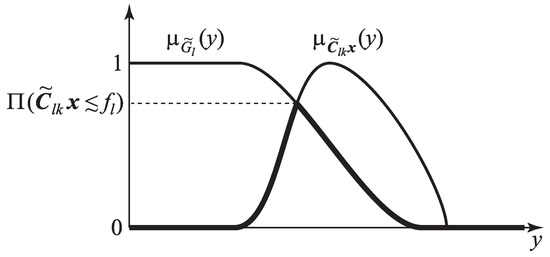
Figure 10.
Degree of possibility .
5.1.2. Necessity Measure
For DMs who make decisions from pessimistic view points, a necessity measure is recommended. The necessity measure defined by Zadeh [44] and Dubois and Prade [34] is as follows:
Definition 13.
(Necessity measure)
Let and be fuzzy sets characterized by membership functions and , respectively. Then, under a possibilistic distribution of of a possibilistic variable α, the necessity measure of the event that α is in a fuzzy set is defined as follows:
Then, in view of (22), the degree of necessity that the objective function value for any event satisfies the fuzzy goal is defined as
Figure 11 illustrates the degree of necessity defined by (23), which is the ordinate of the crossing point between the membership functions of fuzzy goal and the upside-down of the membership function of the objective function .
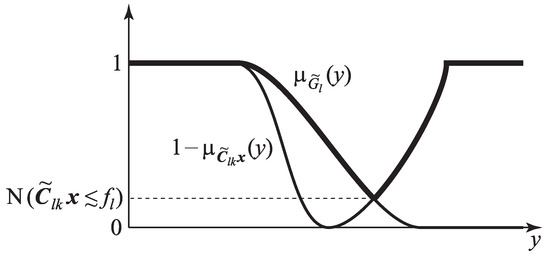
Figure 11.
Degree of necessity .
Possibilistic programming [45,46] is one of the most promising tools for handling mathematical optimization problems with ambiguous parameters.
5.2. Optimization Criteria in Fuzzy Random Environments
Possibilistic programming approaches cannot directly be applied to solving problems with discrete fuzzy random variables. This is because the degrees of possibility or necessity defined in (21) or (23) are not constants but vary dependent on events .
In this section, taking into consideration both fuzziness and randomness involved in the coefficients of the problems, we newly propose some useful optimization criteria for problems with discrete fuzzy random variables. As novel optimization criteria, we provide possibility-based probabilistic expectation (PPE) and necessity-based probabilistic expectation (NPE) as follows:
Definition 14.
(Possibility-based probabilistic expectation (PPE))
Let be n dimensional coefficient row vectors of fuzzy random variables in (multi-objective) LPP (15). Suppose that the realized value of is a fuzzy set (or fuzzy number as a special case) . Let be the degree of possibility for a fixed event defined in (21). By using which is the probability that an event or scenario occurs, the optimization criterion called a possibility-based probabilistic expectation (PPE) is defined and calculated as follows:
where denotes a probabilistic expectation.
Possibility measures are recommended to optimistic DMs. On the other hand, since DMs are not always optimistic in general, we introduce the following new optimization criterion based on necessity measures in order to construct an optimization criterion for pessimistic DMs:
Definition 15.
(Necessity-based probabilistic expectation (NPE))
Let be n dimensional coefficient row vectors of fuzzy random variables in (multi-objective) LPP (15). Suppose that the realized value of is a fuzzy set (or fuzzy number as a special case) . Let be the degree of necessity for a fixed event defined in (21). Then, the following optimization criterion is said to be necessity-based probabilistic expectation (NPE):
6. Discrete Fuzzy Random Linear Programming Models Using Possibility/Necessity-Based Probabilistic Expectation
On the basis of the new optimization criteria defined as (24) or (25) in the previous section, we propose new linear programming-based decision making models in fuzzy stochastic environments.
6.1. Possibility-Based Probabilistic Expectation (PPE) Model
When the DM is optimistic, it is reasonable to use the model based on PPE. Then, we consider the following problem to maximize the probabilistic expectation of the degree of possibility:
[Possibility-based probabilistic expectation model (PPE model)]
where the objective functions of problem (26) are given as (24).
In general, problem (26) is a multi-objective programming problem. Especially in the case of , (26) becomes a single-objective programming problem, and the optimal solution is a feasible solution which maximizes the objective function. On the other hand, when , the problem to be solved has multiple objective functions, which means there does not generally exist a complete solution that simultaneously maximizes all the objective functions. In such multi-objective cases, one of reasonable solution approaches to (26) is to seek a solution satisfying Pareto optimality, called a Pareto optimal solution. We define Pareto optimal solutions of (26). Firstly, we introduce the concepts of weak Pareto optimal solution as follows:
Definition 16.
(Weak Pareto optimal solution of PPE model)
is said to be a weak Pareto optimal solution of the possibility-based probabilistic expectation model if and only if there is no such that
for all .
As a stronger concept than a weak Pareto optimal solution, a (strong) Pareto optimal solution of (26) is defined as follows:
Definition 17.
((Strong) Pareto optimal solution of PPE model)
is said to be a (strong) Pareto optimal solution of the possibility-based probabilistic expectation model if and only if there is no such that for all , and that for at least one .
In order to obtain a (weak/strong) Pareto optimal solution of PPE model, we consider the following maximin problem, which is one of scalarization methods for obtaining a (weak/strong) Pareto optimal solution of multi-objective programming problems [47]:
[Maximin problem for PPE model]
In the theory of multi-objective optimization, it is known that an optimal solution of the maximin problem assures at least weak Pareto optimality. Then, we show the following proposition:
Proposition 1.
(Weak Pareto optimality of the maximin problem for PPE model)
Let be an optimal solution of problem (27). Then, is a weak Pareto optimal solution of problem (26), namely, a weak Pareto optimal solution for PPE model.
Proof.
Assume that an optimal solution of (27) is not a weak Pareto optimal solution of PPE model defined in Definition 16. Then, there exists a feasible solution of (27) such that for all . Then, it follows
This contradicts the fact that is an optimal solution of (27). ☐
Since an optimal solution of (27) is not always a (strong) Pareto optimal solution but only a weak Pareto optimal solution in general, we consider the following augmented maximin problems in order to find a solution satisfying strong Pareto optimality instead of weak Pareto optimality.
[Augmented maximin problem for PPE model]
where is a sufficiently small positive constant, say .
In the theory of multi-objective optimization [47], it is known that an optimal solution of the augmented maximin problem assures (strong) Pareto optimality. Then, we obtain the following proposition:
Proposition 2.
((Strong) Pareto optimality of augmented maximin problem for PPE model)
Let be an optimal solution of problem (28). Then, is a (strong) Pareto optimal solution of (26), namely, a (strong) Pareto optimal solution for PPE model.
Proof.
Assume that an optimal solution of (28), denoted by , is not (strong) Pareto optimal solution of PPE model. Then, there exists such that
for all , and that for at least one . Then, it follows
Therefore, it holds that
This contradicts the fact that is an optimal solution of the augmented minimax problem. ☐
6.2. Necessity-Based Probabilistic Expectation Model (NPE Model)
Unlike the case discussed in the previous section, when the DM is pessimistic, the NPE model is recommended, instead of the PPE model. This section is devoted to addressing how the necessity-based probabilistic expectation (NPE) model based on (25) can be solved in the case of linear membership functions.
Using the necessity-based probabilistic mean defined in (25), we consider another new decision making model called NPE model and formulate the mathematical programming problem as follows:
[Necessity-based probabilistic expectation model (NPE model)]
When , (29) is a single-objective problem. Otherwise, namely, when , (29) is a multi-objective problem in which a solution satisfying (strong) Pareto optimality, called a (strong) Pareto optimal solution, is considered to be a reasonable optimal solution. We define (strong) Pareto optimal solutions of (29). The concept of weak Pareto optimal solution for NPE model is defined as follows:
Definition 18.
(Weak Pareto optimal solution of NPE model)
is said to be a weak Pareto optimal solution of the necessity-based probabilistic expectation model if and only if there is no such that
for all .
As a stronger concept than weak Pareto optimal solutions, (strong) Pareto optimal solutions of (29) is defined as follows:
Definition 19.
((Strong) Pareto optimal solution of NPE model)
is said to be a (strong) Pareto optimal solution of the necessity-based probabilistic expectation model if and only if there is no such that for all , and that for at least one .
Scalarization-Based Problems for Obtaining a Pareto Optimal Solution
In order to obtain a (weak) Pareto optimal solution of NPE model, we consider the following maximin problem, which is one of well-known scalarization methods for solving multi-objective optimization problems:
[Maximin problem for NPE model]
Similar to the case of PPE model discussed in the previous section, we obtain the following proposition:
Proposition 3.
(Weak Pareto optimality of the maximin problem for NPE model)
Let be an optimal solution of problem (30). Then, is a weak Pareto optimal solution of (29), namely, a weak Pareto optimal solution for NPE model.
Since the proof of Proposition 3 is very similar to that of Proposition 1, we omit its proof. Similar to the property of the optimal solution of problem (29), an optimal solution of (30) is not always a (strong) Pareto optimal solution but only a weak Pareto optimal solution in general.
To find a solution satisfying (strong) Pareto optimality instead of weak Pareto optimality, we consider the following augmented maximin problem.
[Augmented maximin problem for NPE model]
where is a sufficiently small positive constant, say .
Then, we obtain the following proposition:
Proposition 4.
((Strong) Pareto optimality of augmented maximin problem for NPE model)
Let be an optimal solution of problem (31). Then, is a (strong) Pareto optimal solution of (29), namely, a (strong) Pareto optimal solution for NPE model.
We omit the proof of Proposition 4 because it is similar to that of Proposition 2.
7. Solution Algorithms
7.1. Solution Algorithm for the PPE Model
Now we discuss how to solve problem (28) in order to obtain a (strong) Pareto optimal solution for the PPE model. Here, we focus on the case where all the membership functions of fuzzy numbers and fuzzy goals are represented by linear membership functions. To be more specific, we restrict ourselves to considering the case that the coefficients of objective function in (15) are triangular fuzzy random variables defined in (11), and that the membership function of the fuzzy goal for the lth objective function is the following piecewise linear membership function, called a linear membership function:
where and are parameters whose values are determined by a DM. Figure 12 shows the membership of fuzzy goal which is expressed by a linear membership function.
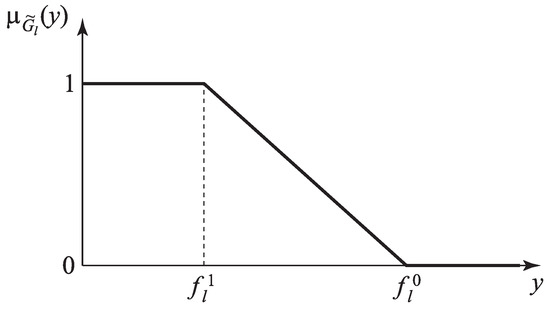
Figure 12.
Linear membership function of a fuzzy goal .
From a practical aspect, it is important to show how to determine the values of parameters and in the linear membership functions (32) of fuzzy goals , . When a DM can easily set the values of and , , these values should be determined by the DM’s own idea or choice. On the other hand, when it is difficult for a DM to determine the parameter values of fuzzy goals, we recommend that the values of and are determined as follows:
where denotes an optimal solution of the following lth optimization problem which has a single objective function:
The above calculation method is similar to the Zimmermann’s method [48] which was originally introduced for fuzzy (non-stochastic) linear programming.
We consider the case where the coefficients of the objective function are given as discrete triangular fuzzy random variables. Assuming that and are given by (18) and (32), respectively, we can show that the following theorem holds:
Theorem 1.
Assume that is a discrete triangular fuzzy random variable whose realized values for events are triangular fuzzy numbers characterized by (18), and that the membership function of each fuzzy goal is characterized by (32) and (33). Then, the possibility-based probabilistic expectation (PPE) is calculated as
where
Proof.
The calculation of is done by dividing into three cases, namely, 1) Case 1: If , 2) Case 2: If , 3) Case 3: If .
- Case 1: If the value of is equal to 1, as shown in Figure 13.
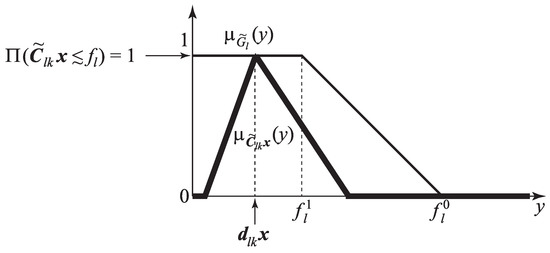 Figure 13. Case 1 in the proof of Theorem 1.
Figure 13. Case 1 in the proof of Theorem 1. - Case 2: If , the value of is calculated as the ordinate of the crossing point between the membership function of fuzzy goal and the objective function , as shown in Figure 14. The abscissa of the crossing point of two functions ( and ) is obtained by solving the equation
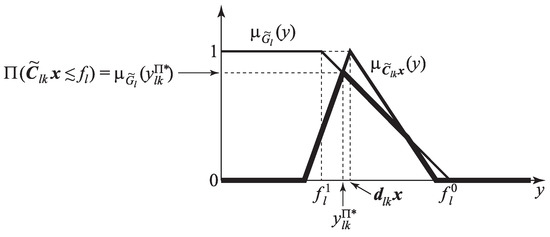 Figure 14. Case 2 in the proof of Theorem 1.Then, the solution of (37) isConsequently, the ordinate of the crossing point is calculated asfor , .
Figure 14. Case 2 in the proof of Theorem 1.Then, the solution of (37) isConsequently, the ordinate of the crossing point is calculated asfor , . - Case 3: If , the value of is equal to 0, as shown in Figure 15.
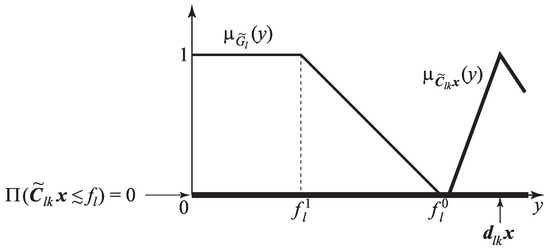 Figure 15. Case 3 in the proof of Theorem 1.
Figure 15. Case 3 in the proof of Theorem 1.
Therefore, the computational results of the above three cases can be integrated and represented as a single form
Consequently, is calculated based on Definition 14 as follows:
☐
Figure 13, Figure 14 and Figure 15 illustrate the degrees of possibility that the fuzzy goal is fulfilled under the possibility distribution , each of which is corresponding to Case 1, Case 2 and Case 3, respectively. In each figure, the bold line expresses the value of . In Figure 13, the maximum of the bold line is 1. In Figure 14, the maximum of the bold line is between 0 and 1. In Figure 15, the maximum of the bold line is 0.
From Proposition 2, the optimal solution of augmented maximin problem (28) is a (strong) Pareto optimal solution. In the case of linear membership functions, the augmented maximin problem (28) for the PPE model is formulated using (35) and (36) as follows:
[Augmented maximin problem for PPE model (linear membership function case)]
where is given by (36), namely,
and is a sufficiently small positive constant.
Now we summarize an algorithm for obtaining a (strong) Pareto optimal solution of possibility-based probabilistic expectation model (PPE model) in the multi-objective case.
[An algorithm for obtaining a (strong) Pareto optimal solution of PPE model (linear membership function case)]
- Step 1:
- (Calculation of possible objective function values)Using a linear programming technique, solve individual minimization problems (34) for , namelyand obtain optimal solutions of the lth minimization problems for .
- Step 2:
- (Setting of membership functions of fuzzy goals)Ask the DM to specify the values of and , . If the DM has no idea of how and , are determined, then the DM can set the following values calculated by (33) asusing the optimal solutions obtained in Step 1.
- Step 3:
- (Derivation of a strong Pareto optimal solution of PPE model)Using a nonlinear programming technique, solve the following augmented maximin problem (38):whereand is a sufficiently small positive constant.
It should be noted here that (38) is a nonlinear programming problem (NLPP) with linear constraints in which the objective function has points at which the gradient is not calculated. In such a case, a certain heuristic or metaheuristic algorithm can be used to solve the problem. Another applicable solution method is the Nelder-Mead method [49] which can solve a linear-constrained NLPPs without any information on the derivative of the objective function and constraints.
7.2. Solution Algorithm for the NPE Model
When a DM is pessimistic for the attained objective function values, a necessity-based probabilistic expectation (NPE) model is recommended. In a manner similar to Theorem 1 which holds for the PPE model, we obtain the following theorem with respect to the NPE model:
Theorem 2.
Assume that is a discrete triangular fuzzy random variable whose realized values for events are triangular fuzzy numbers characterized by (18), and that the membership function of each fuzzy goal is characterized by (32) and (33). Then, the necessity-based probabilistic expectation defined in (25) is calculated as
where
Proof.
From the definition of necessity measure, the calculation of is done by dividing by three cases, namely, 1) Case 1: If , 2) Case 2: If , 3) Case 3: If .
- Case 1: If , the value of is equal to 1, as shown in Figure 16.
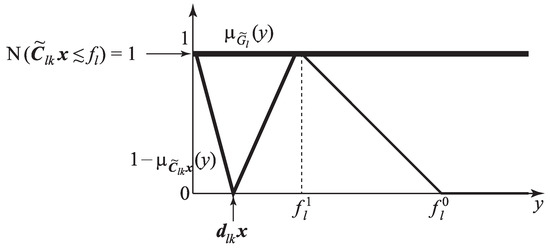 Figure 16. Case 1 in the proof of Theorem 2.
Figure 16. Case 1 in the proof of Theorem 2. - Case 2: If , the value of is calculated as the ordinate of the crossing point between the membership functions of fuzzy goal and the objective function , as shown in Figure 17. The abscissa of the crossing point of two functions ( and ) is obtained by solving the equation
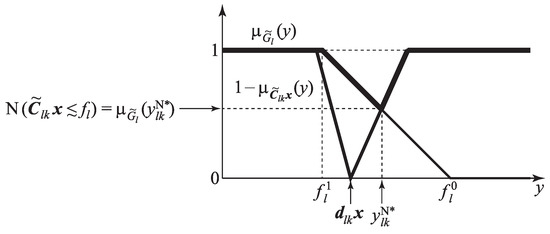 Figure 17. Case 2 in the proof of Theorem 2.Then, the solution of (41) isConsequently, the ordinate of the crossing point is calculated asfor , .
Figure 17. Case 2 in the proof of Theorem 2.Then, the solution of (41) isConsequently, the ordinate of the crossing point is calculated asfor , . - Case 3: If , the value of is equal to 0, as shown in Figure 18.
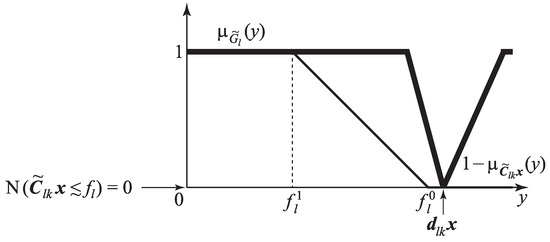 Figure 18. Case 3 in the proof of Theorem 2.
Figure 18. Case 3 in the proof of Theorem 2.
The computational results of the three cases above can be integrated and expressed as a single form
Consequently, the necessity-based probabilistic expectation defined in (25) is calculated as
☐
Figure 16, Figure 17 and Figure 18 illustrate the degrees of necessity that the fuzzy goal is fulfilled under the possibility distribution , each of which is corresponding to Case 1, Case 2 and Case 3, respectively. In each figure, the bold line expresses the values of . In Figure 16, the minimum of the bold line is 1. In Figure 17, the minimum of the bold line is between 0 and 1. In Figure 18, the minimum of the bold line is 0.
From Proposition 4, the optimal solution of augmented maximin problem (31) is a (strong) Pareto optimal solution of NPE model. In the case of linear membership functions, the augmented maximin problem (42) for NPE model is formulated using (39) and (40) as follows:
[Augmented maximin problem for the NPE model (linear membership function case)]
where is given by (40), namely,
and is a sufficiently small positive constant.
Now we summarize an algorithm for obtaining a (strong) Pareto optimal solution of the necessity-based probabilistic expectation model (NPE model) in the multi-objective case.
[An algorithm for obtaining a (strong) Pareto optimal solution of NPE model (linear membership function case)]
- Step 1:
- (Calculation of possible objective function values)By using a linear programming technique, solve individual minimization problems (34) for , namelyand obtain optimal solutions of the lth minimization problems for .
- Step 2:
- (Setting of membership functions of fuzzy goals)Ask the DM to specify the values of and , . If the decision has no idea of how and , are determined, the DM could set the values calculated by (33) asusing the optimal solutions obtained in Step 1.
- Step 3:
- (Derivation of a (strong) Pareto optimal solution of the NPE model)Solve the following augmented maximin problem (42) using a nonlinear programming technique:where is given by (40), namely,and is a sufficiently small positive constant.
Similar to the case of PPE model in the previous section, (42) is a nonlinear programming problem with linear constraints, which can be solved by a certain nonlinear programming technique.
8. Numerical Experiments
In order to demonstrate feasibility and efficiency of the proposed model, we consider an example of agriculture production problems. One of classical approaches to crop planning problems is stochastic programming [1] using several stochastic events or scenarios related to climate and/or economic conditions. However, it is sometimes difficult to definitely estimate the exact values of the profit and the working time in crop planning problems because of lack of data and/or some factors such as human skills. Zeng et al. [50] considered a fuzzy multi-objective programming approach to a crop planning problem. In this section, we apply the proposed model to solve a crop planning problem in a fuzzy stochastic environment where the profit and the working times are given as discrete fuzzy random variables.
In order to solve the problem, we employ ‘constrOptim’ function which is prepared as a standard function in the R language [33] and is often used as a solver for NLPPs with linear constraints. It should be stressed here that some state-of-the-art algorithms based on heuristics or metaheuristics [51] may solve problems more efficiently. Nonetheless, we do not propose a specific solution algorithm for the proposed model in this article, because the proposal of a specific solution algorithm is not a purpose of this paper. The R language is easy to use for many researchers and practical persons, even if they are not good at writing their own programming codes.
8.1. Crop Area Planning Problem Under a Fuzzy Random Environment
Assume that an agricultural company (DM) produces 5 kinds of summer vegetables (bell pepper, cucumber, eggplant, tomato and watermelon). We consider the following fuzzy random LPP with bi-objective functions (), 5 decision variables () and 5 constraints ():
where the first objective function represents the profit ( thousand yen) earned by producing and selling vegetables, and the second one expresses the total working time ( h). Let , denote the growing area () of vegetables (bell pepper), (cucumber), (eggplant), (tomato) and (watermelon), respectively.
In the objective function, let and be the profit and the working time per unit of vegetables , respectively. Assume that and , are estimated as discrete triangular fuzzy random variables. On the basis of the research results on relationships between vegetable diseases and humidity [52], we assume that the number of events (scenarios) related to the 1st objective function and the second one are 5 (). To be more specific, the set of events are given as and as shown in Table 1.

Table 1.
Events related to the 1st and 2nd objective functions.
Table 2 and Table 3 show the parameter values of the realized fuzzy numbers and , , , which characterize fuzzy random variables and , , respectively. The values of are given in Table 2, each of which is based on the statistical data in 2007 by the Japanese Ministry of Agriculture, Forestry and Fisheries (JMAFF) [53]. The values of are given in Table 3, each of which is based on the report of Mekonnen et al. [54]. By taking into consideration the degree of risk of producing different vegetables, it is assumed that the parameter values of and for are larger than those for .

Table 2.
Parameters of in the 1st objective function.

Table 3.
Parameters of in the 2nd objective function.
As shown in problem (43), there are five constraints in the crop planning problem. Table 4 and Table 5 show the coefficients of these constraints. The 1st constraint reflects that there is the upper limit of the total cost of cropping, sales, etc. The unit of and in the 1st constraint is converted from a unit area to 10 thousand yen, based on the statistical data in 2007 by JMAFF [53]. The 2nd constraint and the 3rd one represents the upper limit and the lower limit of the total growing area of vegetables, respectively. The 4th and 5th constraints represent that the agricultural company signs contracts with two major customers for selling certain amounts of specific vegetables. In these two constraints, the unit for these constraints is converted from area to kilo gram, based on the statistical data in 2007 by JMAFF [53].

Table 4.
Left-hand side coefficients in constraints.

Table 5.
Right-hand side values in constraints.
In problem (43), the 1st objective function is the profit to be maximized. Since the algorithm proposed in Section 5 is valid for minimization problems, we transform the maximization problem into a minimization problem by multiplying the original 1st objective function by as follows:
In order to utilize the results obtained in the previous sections, we transform maximization into minimization of the 1st objective function by setting as follows:
where are discrete triangular fuzzy random variables expressed as . Then, the following remark should be noted:
Remark 1.
Let and be L-R fuzzy random variables expressed as and . If , it holds that
Then, the values of parameters in the 1st objective function as shown in Table 2 can be replaced by Table 6, where we use the property of triangular fuzzy random variables described in Remark 1.

Table 6.
Parameters of in the 1st objective function.
Based on the algorithm proposed in the previous section, a Pareto optimal solution in the crop planning problem is obtained. Firstly, the fuzzy goals for each objective function are given, by solving LPPs in Step 1 and computing and for in Step 2, as and . In Step 3, based on the DM’s preference, the augmented maximin problems (38) and/or (42) are solved, which corresponds to the possibility-based probabilistic expectation model (PPE model) and the necessity-based probabilistic expectation model (NPE model), respectively. Since the obtained solutions through the function in the R language do not always satisfy global optimality but local optimality, we apply this function to 100 initial solutions that are randomly generated, and select the best solution among 100 local optimal solutions. Thus, we obtain the following optimal solutions for PPE model and NPE model:
where and are optimal solutions of (38) and (42), respectively, and and are their objective function values, respectively. From the computational results, the possibility-based probabilistic expectation model (PPE model) tends to crop high-risk high-return vegetables such as bell pepper, cucumber and watermelon, and few areas are assigned to other vegetables. On the other hand, the necessity-based probabilistic expectation model (NPE model) has a tendency to increase the cropping areas of low-risk low-return vegetables such as tomato and to decrease those of high-risk low-return vegetables such as bell pepper.
8.2. Computational Times for Different Size Problems
As we mentioned before, we do not propose a specific solution algorithm for the proposed model, because it may take much time and efforts for researchers or practical persons to write programming codes even if we propose new solution algorithms.
Instead of proposing a specific solution algorithm, we use the R language and show the R language can solve problems with hundreds of decision variables in a practical computational time. We expect that the use of the R language can promote the use of our model for solving real-world problems in fuzzy stochastic environments.
In order to show the applicability of the R language to our model in terms of computational time, we conduct additional experiments using 5 numerical examples in which the number of decision variables and that of constraint are different. To be more precise, the numbers of decision variables in 7 examples are , respectively. The number of constraints in each example is set to be the half number of decision variables.
To focus on the effect of the number of decision variables and that of constraints, the number of the objective functions and that of events (scenarios) are fixed. To be more specific, we fix the number of the objective functions and that of events (scenarios) as 5 () and 10 (), respectively.
The values of parameters are randomly chosen in , and are the absolute values of the products of and values randomly chosen in for , , . As for the constraints, the values of in matrix A are randomly chosen in , and the values of are given as the sum of elements in for any , . Similar to the experiment in Section 8.1, we used constrOptim function in the R language and conducted 30 runs in which initial solutions are randomly generated. We conducted this numerical experiment using R version 3.2.0 on iMac (OS X Yosemite version 10.10.3, CPU: 3.4 GHz Intel Core i7, RAM: 32 GB 1600 MHz DDR3). Table 7 shows computational times for solving 7 problem instances.

Table 7.
Computational times for different size problems.
Figure 19 shows the relationship between the number of decision variables and computational times obtained in Table 7. It is shown from this graph that the computational time linearly increases as the numbers of decision variables and constraints increase.
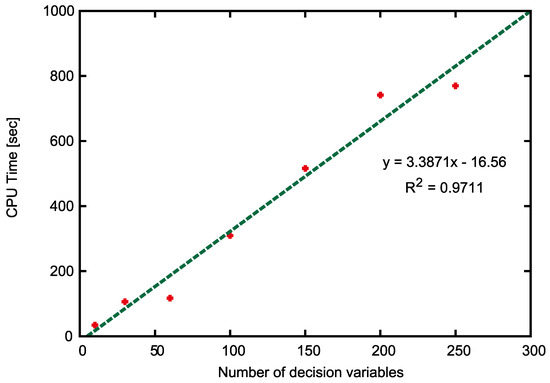
Figure 19.
Relationship between the number of decision variables and computational times.
9. Conclusions
In this paper, we have considered LPPs in which the coefficients of the objective functions are discrete fuzzy random variables. Incorporating possibility and necessity measures into a probability measure, we have proposed new decision making models in fuzzy stochastic environments, called possibility/necessity-based probabilistic expectation model (PPE/NPE model), which is to maximize the expectation of the degree of possibility or necessity that the objective function values satisfy the given fuzzy goals. It has been shown that the formulated problems based on the proposed models can be transformed into deterministic nonlinear (multi-objective) programming problems, especially, into more simple problems when linear membership functions are used. In addition, we have defined (strong) Pareto optimal solutions of the proposed models in the multi-objective case, and proposed an algorithm for obtaining a solution satisfying (strong) Pareto optimality. In order to show how the proposed model can be applied to real-world problems, we have conducted a numerical experiment with an agriculture production problem. We also have demonstrated that a standard function in the R language is applicable to solve the problems with hundreds of decision variables in a practical computational time.
In the near future, we will show a generalized variance minimization model which is an extended version discussed in the previous study [32]. Furthermore, some applications of the proposed models to real-world problems will be discussed elsewhere.
Acknowledgments
This work was supported by JSPS KAKENHI Grant Number 17K01276.
Author Contributions
Hideki Katagiri proposed the method and wrote the paper. Kosuke Kato and Takeshi Uno analyzed the validity of the method and performed the numerical experiments.
Conflicts of Interest
The authors declare no conflict of interest.
References
- Birge, J.R.; Louveaux, F. Introduction to Stochastic Programming, 2nd ed.; Springer: Berlin/Heidelberg, Germany, 2011. [Google Scholar]
- Dantzig, G.B. Linear programming under uncertainty. Manag. Sci. 1955, 1, 197–206. [Google Scholar] [CrossRef]
- Aiche, F.; Abbas, M.; Dubois, D. Chance-constrained programming with fuzzy stochastic coefficients. Fuzzy Optim. Decis. Mak. 2013, 12, 125–152. [Google Scholar] [CrossRef]
- Katagiri, H.; Sakawa, M. Interactive multiobjective fuzzy random programming through the level set-based probability model. Inf. Sci. 2011, 181, 1641–1650. [Google Scholar] [CrossRef]
- Inuiguchi, M.; Kato, K.; Katagiri, H. Fuzzy Multi-Criteria Optimization: Possibilistic and Fuzzy/Stochastic Approaches. In Multiple Criteria Decision Analysis; Springer: Berlin/Heidelberg, Germany, 2016; pp. 851–902. [Google Scholar]
- Katagiri, H.; Sakawa, M.; Kato, K.; Nishizaki, I. Interactive multiobjective fuzzy random linear programming: Maximization of possibility and probability. Eur. J. Oper. Res. 2008, 188, 530–539. [Google Scholar] [CrossRef]
- Katagiri, H.; Uno, T.; Kato, K.; Tsuda, H.; Tsubaki, H. Random fuzzy multiobjective programming: Optimization of possibilistic Value at Risk (pVaR). Expert Syst. Appl. 2013, 40, 563–574. [Google Scholar] [CrossRef]
- Luhandjula, M.K. Fuzzy stochastic linear programming: Survey and future research directions. Eur. J. Oper. Res. 2006, 174, 1353–1367. [Google Scholar] [CrossRef]
- Luhandjula, M.K.; Joubert, J.W. On some optimisation models in a fuzzy-stochastic environment. Eur. J. Oper. Res. 2010, 207, 1433–1441. [Google Scholar] [CrossRef]
- Nematian, J. A random fuzzy multi-objective linear programming approach through possibility theory. Eur. J. Ind. Eng. 2015, 9, 512–537. [Google Scholar] [CrossRef]
- Yano, H. Fuzzy decision making for fuzzy random multiobjective linear programming problems with variance covariance matrices. Inf. Sci. 2014, 272, 111–125. [Google Scholar] [CrossRef]
- Yano, H. Multiobjective programming problems involving fuzzy coefficients, random variable coefficients and fuzzy random variable coefficients. Int. J. Uncertain. Fuzziness Knowl. Based Syst. 2015, 23, 483–504. [Google Scholar] [CrossRef]
- Katagiri, H.; Sakawa, M.; Kato, K.; Nishizaki, I. A fuzzy random multiobjective 0-1 programming based on the expectation optimization model using possibility and necessity measures. Math. Comput. Model. 2004, 40, 411–421. [Google Scholar] [CrossRef]
- Dutta, P.; Chakraborty, D.; Roy, A.R. A single-period inventory model with fuzzy random variable demand. Math. Comput. Modell. 2005, 41, 915–922. [Google Scholar] [CrossRef]
- Wang, X. Continuous review inventory model with variable lead time in a fuzzy random environment. Expert Syst. Appl. 2011, 38, 11715–11721. [Google Scholar] [CrossRef]
- Giri, P.K.; Maiti, M.K.; Maiti, M. Entropy based solid transportation problems with discounted unit costs under fuzzy random environment. OPSEARCH 2014, 51, 479–532. [Google Scholar] [CrossRef]
- Nematian, J. A robust single row facility layout problem with fuzzy random variables. Int. J. Adv. Manuf. Technol. 2014, 72, 255–267. [Google Scholar] [CrossRef]
- Wang, S.; Huang, G.; Baetz, B.W. An inexact probabilistic-possibilistic optimization framework for flood management in a hybrid uncertain environment. IEEE Trans. Fuzzy Syst. 2015, 23, 897–908. [Google Scholar] [CrossRef]
- Katagiri, H.; Kato, K.; Hasuike, T. A random fuzzy minimum spanning tree problem through a possibility-based value at risk model. Expert Syst. Appl. 2012, 39, 205–220. [Google Scholar] [CrossRef]
- Katagiri, H.; Sakawa, S.; Ishii, H. Fuzzy random bottleneck spanning tree problems using possibility and necessity measures. Eur. J. Oper. Res. 2004, 152, 88–95. [Google Scholar] [CrossRef]
- Gil, M.A. Fuzzy random variables: Development and state of the art. Proccedings of the 25th Linz Seminar on Fuzzy Set Theory, Linz, Austria, 3–7 February 2004; pp. 11–15. [Google Scholar]
- Gil, M.A.; Lopez-Diaz, M.; Ralescu, D.A. Overview on the development of fuzzy random variables. Fuzzy Sets Syst. 2006, 157, 2546–2557. [Google Scholar] [CrossRef]
- Klement, E.P.; Puri, M.L.; Ralescu, D.A. Limit theorems for fuzzy random variables. Proc. R. Soc. Lond. 1986, 407, 171–182. [Google Scholar] [CrossRef]
- Kwakernaak, H. Fuzzy random variables-1. Definitions and theorems. Inf. Sci. 1978, 15, 1–29. [Google Scholar] [CrossRef]
- Puri, M.L.; Ralescu, D.A. Fuzzy random variables. J. Math. Anal. Appl. 1986, 14, 409–422. [Google Scholar] [CrossRef]
- Shapiro, A.F. Fuzzy random variables. Insur. Math. Econ. 2009, 44, 307–314. [Google Scholar] [CrossRef]
- Luhandjula, M.K. Fuzziness and randomness in an optimization framework. Fuzzy Sets Syst. 1996, 77, 291–297. [Google Scholar] [CrossRef]
- Luhandjula, M.K.; Gupta, M.M. On fuzzy stochastic optimization. Fuzzy Sets Syst. 1996, 81, 47–55. [Google Scholar] [CrossRef]
- Liu, B. Fuzzy random chance-constrained programming. IEEE Trans. Fuzzy Syst. 2001, 9, 713–720. [Google Scholar]
- Liu, Y.-K.; Liu, B. A class of fuzzy random optimization: Expected value models. Inf. Sci. 2003, 155, 89–102. [Google Scholar] [CrossRef]
- Katagiri, H.; Mermri, E.B.; Sakawa, M.; Kato, K.; Nishizaki, I. A possibilistic and stochastic programming approach to fuzzy random MST problems. IEICE Trans. Inf. Syst. 2005, 88, 1912–1919. [Google Scholar] [CrossRef]
- Katagiri, H.; Sakawa, M. A study on fuzzy random linear programming problems based on possibility and necessity measures. In Fuzzy Sets and Systems-IFSA 2003; Springer: Berlin/Heidelberg, Germany, 2003; pp. 725–732. [Google Scholar]
- R Core Team. R: A Language and Environment for Statistical Computing; R Foundation for Statistical Computing: Vienna, Austria, 2014; Available online: http://www.R-project.org/ (accessed on 6 September 2017).
- Dubois, D.; Prade, H. Possibility Theory; John Wiley & Sons: Hoboken, NJ, USA, 1988. [Google Scholar]
- Kruse, R.; Meyer, K.D. Statistics with Vague Data; D. Reidel Publishing Company: Dordrecht, The Netherlands, 1987. [Google Scholar]
- Katagiri, H.; Sakawa, M.; Ishii, H. Studies of stochastic programming models using possibility and necessity measures for linear programming problems with fuzzy random variable coefficients. Electron. Commun. Jpn. Part III 2005, 88, 68–75. [Google Scholar] [CrossRef]
- Katagiri, H.; Sakawa, M.; Kato, K.; Ohsaki, S. An interactive fuzzy satisficing method based on the fractile optimization model using possibility and necessity measures for a fuzzy random multiobjective linear programming problem. Electron. Commun. Jpn. Part III 2005, 88, 20–28. [Google Scholar] [CrossRef]
- Katagiri, H.; Sakawa, M.; Ishii, H. A study on fuzzy random portfolio selection problems based on possibility and necessity measures. Sci. Math. Jpn. 2005, 61, 361–370. [Google Scholar]
- Katagiri, H.; Ishii, H. Chance constrained bottleneck spanning tree problem with fuzzy random edge costs. J. Oper. Res. Soc. Jpn. 2000, 43, 128–137. [Google Scholar] [CrossRef]
- Kaufmann, A.; Gupta, M.M. Introduction to Fuzzy Arithmetic. Theory and Applications; Van Nostrand Reinhold: New York, NY, USA, 1985. [Google Scholar]
- Kwakernaak, H. Fuzzy random variables-II. Algorithms and examples for the discrete case. Inf. Sci. 1979, 17, 253–278. [Google Scholar] [CrossRef]
- Dubois, D.; Prade, H. Fuzzy Sets and Systems: Theory and Application; Academic Press: New York, NY, USA, 1980. [Google Scholar]
- Zadeh, L.A. Fuzzy sets. Inf. Control 1965, 8, 338–353. [Google Scholar] [CrossRef]
- Zadeh, L.A. Fuzzy sets as a basis for a theory of possibility. Fuzzy Sets Syst. 1978, 1, 3–28. [Google Scholar] [CrossRef]
- Inuiguchi, M.; Ichihasi, H. Relative modalities and their use in possibilistic linear programming. Fuzzy Sets Syst. 1990, 35, 303–323. [Google Scholar] [CrossRef]
- Inuiguchi, M.; Ramik, J. Possibilistic linear programming: A brief review of fuzzy mathematical programming and a comparison with stochastic programming in portfolio selection problem. Fuzzy Sets Syst. 2000, 111, 3–28. [Google Scholar] [CrossRef]
- Branke, J.; Deb, K.; Miettinen, K.; Slowinski, R. Multiobjective Optimization: Interactive and Evolutionary Approaches; Springer: Berlin/Heidelberg, Germany, 2008. [Google Scholar]
- Zimmermann, H.J. Fuzzy programming and linear programming with several objective functions. Fuzzy Sets Syst. 1978, 1, 5–55. [Google Scholar] [CrossRef]
- Lange, K. Numerical Analysis for Statisticians, 2nd ed.; Springer: Berlin/Heidelberg, Germany, 2010. [Google Scholar]
- Zeng, X.; Kang, S.; Li, F.; Zhang, L.; Guo, P. Fuzzy multi-objective linear programming applying to crop area planning. Agric. Water Manag. 2010, 98, 134–142. [Google Scholar] [CrossRef]
- Katagiri, H.; Hayashida, T.; Nishizaki, I.; Guo, Q. A hybrid algorithm based on tabu search and ant colony optimization for k-minimum spanning tree problems. Expert Syst. Appl. 2012, 39, 5681–5686. [Google Scholar] [CrossRef]
- Sherf, A.F. Vegetable Diseases and Their Control; John Wiley & Sons: Hoboken, NJ, USA, 1986. [Google Scholar]
- Japanese Ministry of Agriculture, Forestry and Fisheries. Data for business statistics by agricultural products in 2007 (Japanese version only). Available online: http://www.e-stat.go.jp/SG1/estat/List.do?lid=000001061833 (accessed on 6 September 2017).
- Mekonnen, M.M.; Hoekstra, A.Y. The green, blue and grey water footprint of crops and derived crop products. Hydrol. Earth Syst. Sci. 2011, 15, 1577–1600. [Google Scholar] [CrossRef]
© 2017 by the authors. Licensee MDPI, Basel, Switzerland. This article is an open access article distributed under the terms and conditions of the Creative Commons Attribution (CC BY) license (http://creativecommons.org/licenses/by/4.0/).